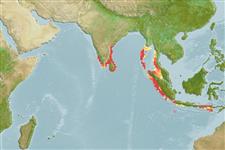Environment: milieu / climate zone / depth range / distribution range
Ecologie
marien rifbewoner; diepte 1 - 125 m (Ref. 89707), usually 1 - 12 m (Ref. 90102). Tropical; 16°N - 11°S, 75°E - 121°E (Ref. 5222)
Eastern Indian Ocean: southern India, Sri Lanka, and southern Indonesia. However, it is likely that its distribution is continuous from Pakistan to Indonesia. Record from the Chagos Archipelago is based on Epinephelus macrospilos (Ref. 6495).
Grootte / Gewicht / Leeftijd
Maturity: Lm ? range ? - ? cm
Max length : 32.0 cm TL mannelijk / geslacht onbekend; (Ref. 5222)
Dorsale stekels (totaal): 11; Dorsale zachte stralen (totaal): 16-18; Anale stekels 3; Anale zachte stralen: 8. Distinguished by having whitish or pale grey color; head, body and fins with numerous close-set round brown spots of unequal sizes; cycloid scales except region under pectoral fins; body with numerous auxiliary scales; greatest depth of body 3.0-3.5 in SL; rounded caudal fin; pelvic fins, 2.2-2.7 in head length (Ref. 90102); further characterized by flat or slightly concave interorbital area, convex dorsal head profile; rounded preopercle, with shallow indentation just above angle and slightly enlarged serrae at the angle; upper edge of operculum slightly convex; subequal posterior and anterior nostrils; maxilla reaches past vertical at rear edge of eye; 2 rows of teeth on midlateral part of lower jaw (Ref. 89707).
Occurs in shallow waters over coral reefs or rocky substrate. It appears to be a small species; a 17 cm SL fish from Sri Lanka has fairly well-developed ovaries. Solitary (Ref 90102).
Levenscyclus en paargedrag
Maturiteit | Voortplanting | Paaien | Eieren | Fecunditeit | Larven
Heemstra, P.C. and J.E. Randall, 1993. FAO Species Catalogue. Vol. 16. Groupers of the world (family Serranidae, subfamily Epinephelinae). An annotated and illustrated catalogue of the grouper, rockcod, hind, coral grouper and lyretail species known to date. Rome: FAO. FAO Fish. Synop. 125(16):382 p. (Ref. 5222)
Status op de Rode Lijst van het IUCN (Ref. 130435)
Gevaar voor de mens
Harmless
Gebruik door de mens
Visserij: commercieel
Meer informatie
Lokale namenSynoniemenMetabolismePredatorenEcotoxicologieVoortplantingMaturiteitPaaienPaaiaggregatiesFecunditeitEierenOntwikkeling van de eieren
ReferentiesAquacultuurAquacultuurprofielKweeklijnenGeneticaElectrophoresesErfelijkheidZiektesVerwerkingNutrientsMassaconversie
Tools
Speciale rapporten
Download XML
Internetbronnen
Estimates based on models
Preferred temperature (Ref.
123201): 28.1 - 29.4, mean 28.6 °C (based on 216 cells).
Fylogenetische diversiteitsindex (Ref.
82804): PD
50 = 0.5000 [Uniqueness, from 0.5 = low to 2.0 = high].
Bayesian length-weight: a=0.01175 (0.00571 - 0.02419), b=3.04 (2.88 - 3.20), in cm total length, based on LWR estimates for this Genus-body shape (Ref.
93245).
Trofisch niveau (Ref.
69278): 3.7 ±0.5 se; based on size and trophs of closest relatives
Weerstandsvermogen (Ref.
120179): Gemiddeld, minimale populatieverdubbelingstijd 1,4-4,4 jaar (Preliminary K or Fecundity.).
Fishing Vulnerability (Ref.
59153): Low vulnerability (22 of 100).
